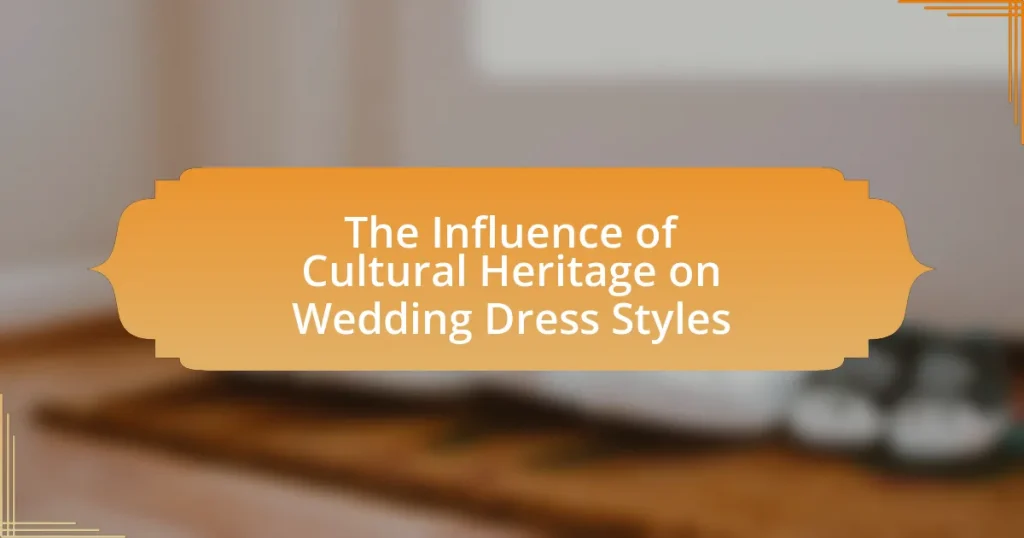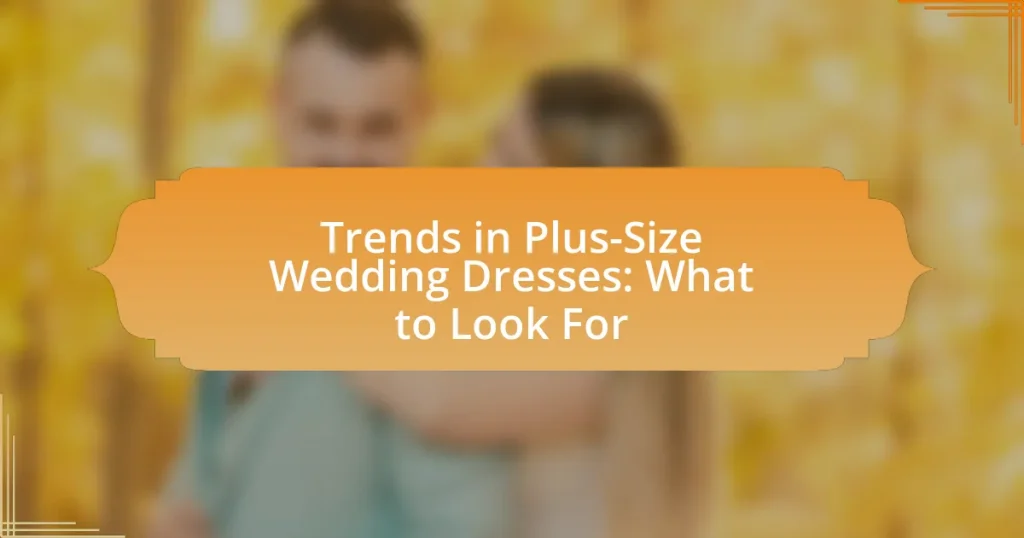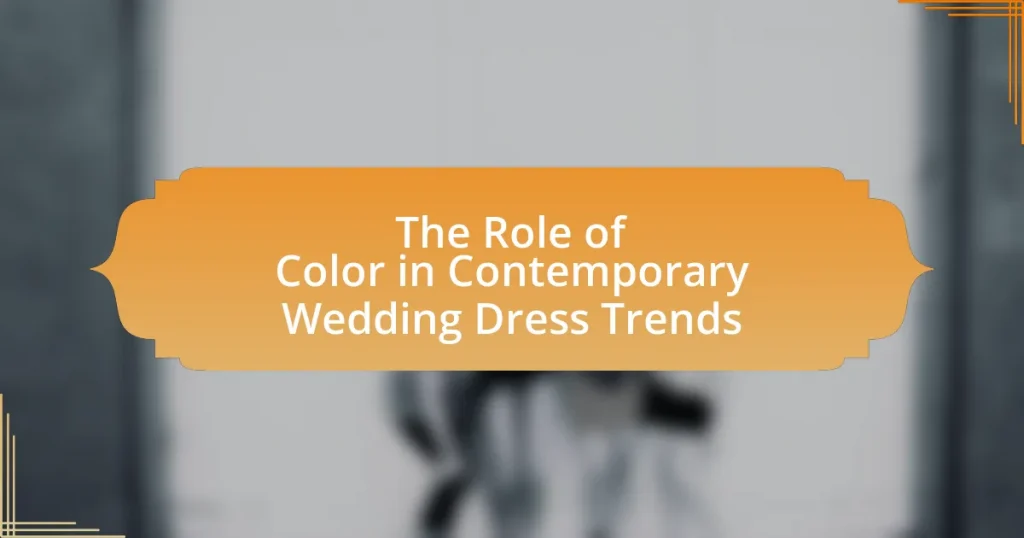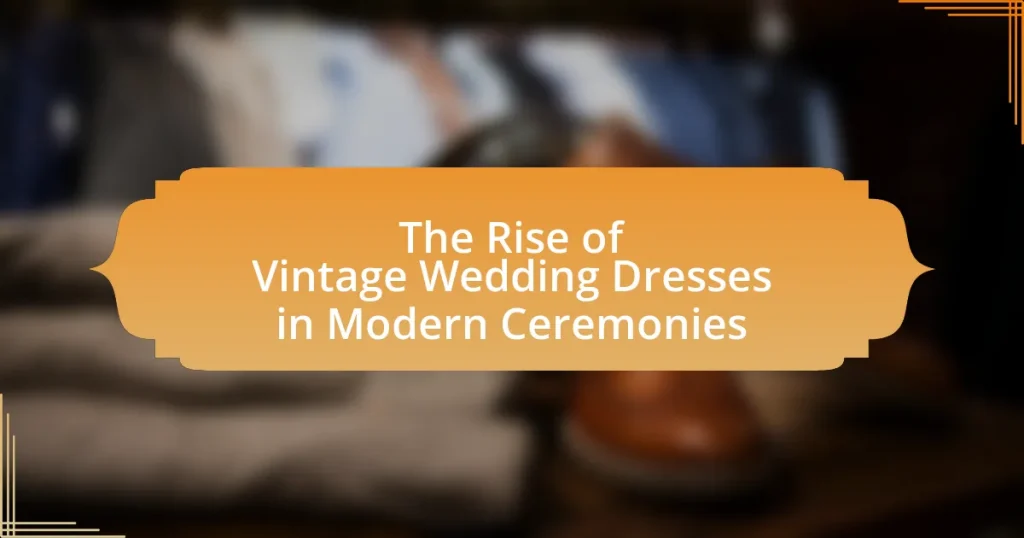The article examines the significant influence of cultural heritage on wedding dress styles, highlighting how traditions, colors, fabrics, and historical events shape contemporary designs. It discusses the symbolic meanings associated with various wedding attire, such as the use of white in Western cultures to signify purity and red in many Asian cultures to represent good fortune. The article also explores how modern trends are reshaping traditional styles, emphasizing the importance of cultural significance in wedding dress choices and the implications of globalization on these designs. Additionally, it provides insights into how couples can honor their heritage through their attire while blending traditional and modern elements.
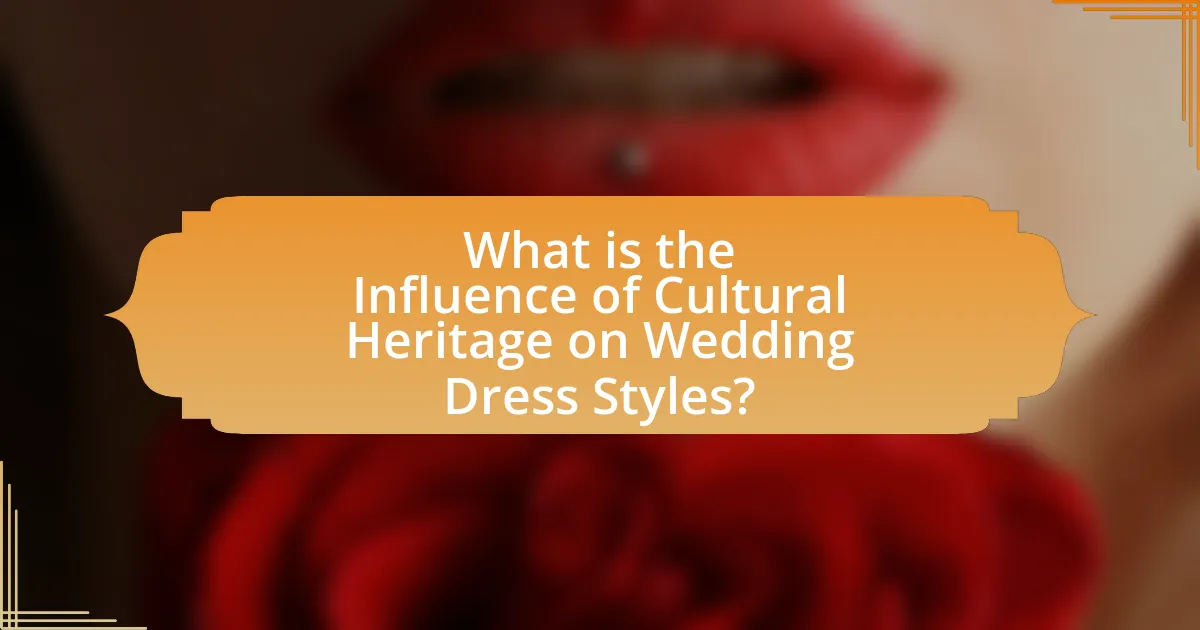
What is the Influence of Cultural Heritage on Wedding Dress Styles?
Cultural heritage significantly influences wedding dress styles by dictating design elements, colors, and fabrics that reflect specific traditions and values. For instance, in Western cultures, white wedding dresses symbolize purity and have been popular since Queen Victoria’s wedding in 1840, while in many Asian cultures, red dresses are favored for their association with good fortune and happiness. Additionally, traditional garments, such as the Indian saree or the Chinese qipao, showcase regional craftsmanship and cultural narratives, further emphasizing the role of heritage in shaping wedding attire. This influence is evident in contemporary designs that incorporate traditional motifs, demonstrating a blend of modernity and cultural significance.
How does cultural heritage shape wedding dress designs?
Cultural heritage significantly shapes wedding dress designs by influencing the materials, colors, patterns, and styles used in these garments. For instance, traditional Chinese wedding dresses often feature red silk and intricate embroidery, symbolizing good fortune and happiness, while Indian bridal attire typically includes vibrant colors and heavy embellishments, reflecting regional customs and religious significance. Historical practices, such as the use of lace in Western weddings, stem from European traditions that emphasize elegance and formality. These elements not only represent the cultural identity of the bride but also connect the wedding to familial and societal traditions, reinforcing the importance of heritage in contemporary design choices.
What are the key elements of cultural heritage that influence wedding attire?
Key elements of cultural heritage that influence wedding attire include traditional customs, regional fabrics, symbolic colors, and historical practices. Traditional customs dictate specific styles and rituals associated with weddings, such as the use of veils or specific garment types, which vary by culture. Regional fabrics, such as silk in Asian cultures or lace in Western traditions, play a significant role in the choice of attire, reflecting local craftsmanship and resources. Symbolic colors, like red in Chinese weddings representing good fortune or white in Western weddings symbolizing purity, directly influence attire selection. Historical practices, such as the incorporation of family heirlooms or specific motifs, further shape the design and significance of wedding attire, ensuring that cultural identity is preserved and celebrated during the ceremony.
How do historical events impact wedding dress styles across cultures?
Historical events significantly influence wedding dress styles across cultures by shaping societal norms, economic conditions, and aesthetic preferences. For instance, the Victorian era in England introduced the white wedding dress, popularized by Queen Victoria’s marriage to Prince Albert in 1840, which symbolized purity and wealth. Similarly, the aftermath of World War II led to a surge in extravagant wedding dresses in Western cultures, reflecting a desire for normalcy and celebration after years of hardship. In contrast, cultural events such as the introduction of Western fashion in Japan during the Meiji Restoration resulted in a blend of traditional kimonos with Western-style dresses, showcasing the impact of globalization on local customs. These examples illustrate how historical milestones directly shape the evolution of wedding attire, reflecting broader cultural shifts and values.
Why is cultural significance important in wedding dress choices?
Cultural significance is important in wedding dress choices because it reflects the values, traditions, and identity of the couple and their families. Wedding dresses often incorporate specific colors, styles, and symbols that are meaningful within a particular culture, such as the use of red in Chinese weddings to symbolize good fortune. This connection to cultural heritage not only honors familial and societal expectations but also enhances the emotional resonance of the ceremony, making the event more meaningful for those involved. For instance, in many cultures, the choice of a wedding dress can signify social status, religious beliefs, or regional customs, thereby reinforcing the couple’s ties to their heritage and community.
What role does symbolism play in wedding dress designs?
Symbolism plays a crucial role in wedding dress designs by conveying cultural meanings and traditions associated with marriage. For instance, the color white in Western cultures symbolizes purity and innocence, while in some Eastern cultures, red signifies good fortune and joy. These symbolic elements are often integrated into the design through color choices, fabric types, and embellishments, reflecting the couple’s cultural heritage and personal beliefs. Historical practices, such as Queen Victoria popularizing the white wedding dress in the 19th century, further illustrate how symbolism shapes contemporary designs, making them not only aesthetic choices but also representations of deeper cultural narratives.
How do cultural traditions dictate the materials and colors used in wedding dresses?
Cultural traditions significantly dictate the materials and colors used in wedding dresses, as they reflect the values, beliefs, and historical practices of different societies. For instance, in Western cultures, white wedding dresses symbolize purity and innocence, a tradition popularized by Queen Victoria in the 19th century. Conversely, in many Asian cultures, red is favored for its connotations of good fortune and happiness, as seen in Chinese weddings where brides often wear red silk dresses. Additionally, the choice of materials can also be influenced by cultural significance; for example, silk is traditionally used in many Asian weddings due to its luxurious feel and historical importance. These practices illustrate how cultural heritage shapes the aesthetic and symbolic elements of wedding attire.
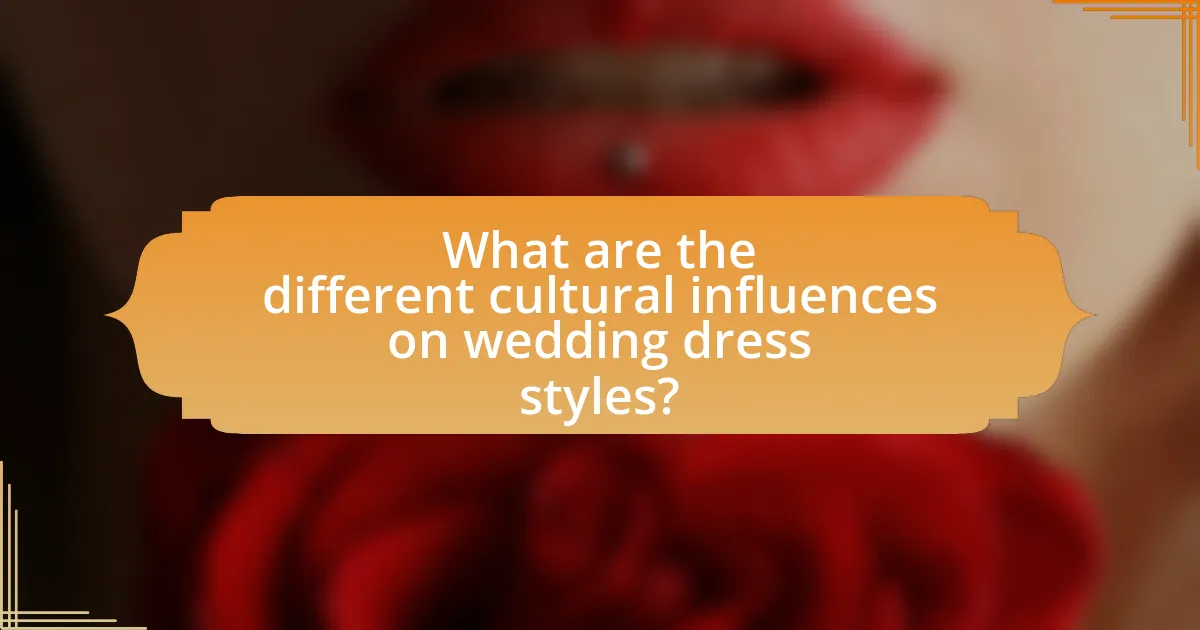
What are the different cultural influences on wedding dress styles?
Different cultural influences on wedding dress styles include regional traditions, religious practices, and historical contexts. For instance, in Western cultures, white wedding dresses symbolize purity and were popularized by Queen Victoria in the 19th century. In contrast, traditional Indian wedding attire often features vibrant colors and intricate embroidery, reflecting cultural significance and regional diversity. Additionally, Chinese brides typically wear red dresses, symbolizing good fortune and happiness, while in African cultures, wedding dresses may incorporate traditional fabrics and patterns that represent heritage and community. These variations illustrate how cultural heritage shapes the aesthetics and meanings behind wedding attire across different societies.
How do Western cultures approach wedding dress styles?
Western cultures predominantly approach wedding dress styles by emphasizing white or ivory gowns, symbolizing purity and new beginnings. This tradition, popularized by Queen Victoria in the 19th century, has led to a widespread preference for elaborate, often floor-length dresses adorned with lace, embroidery, and other embellishments. Additionally, contemporary trends have introduced variations, including colored dresses and non-traditional styles, reflecting individual preferences and cultural diversity. The prevalence of bridal boutiques and fashion designers further illustrates the significance of wedding dress styles in Western cultures, as they cater to a range of tastes while maintaining the core elements of tradition.
What are the traditional elements of Western wedding dresses?
Traditional elements of Western wedding dresses include the color white, which symbolizes purity and innocence, and the use of lace and satin fabrics for elegance. Historically, Queen Victoria popularized the white wedding dress in 1840, shifting away from colorful gowns that were previously common. Additionally, Western wedding dresses often feature a fitted bodice, a full skirt, and embellishments such as embroidery or beading, which enhance the garment’s beauty and significance. These elements reflect cultural values surrounding marriage and femininity, making them integral to the Western wedding tradition.
How have modern trends altered Western wedding dress styles?
Modern trends have significantly altered Western wedding dress styles by introducing diverse silhouettes, fabrics, and colors that reflect individualism and cultural influences. Traditional white gowns have evolved to include a variety of shades, such as blush, champagne, and even bold colors, allowing brides to express their personal style. Additionally, the rise of non-traditional designs, such as jumpsuits and two-piece ensembles, showcases a shift towards comfort and practicality, aligning with contemporary values of self-expression and functionality. The incorporation of cultural elements, such as embroidery and patterns from various heritages, further enriches the aesthetic, making wedding attire more inclusive and representative of diverse backgrounds. This evolution is supported by the increasing popularity of personalized and bespoke wedding dresses, which cater to individual tastes and cultural narratives, reflecting a broader societal trend towards customization in fashion.
What unique characteristics define Eastern wedding dress styles?
Eastern wedding dress styles are characterized by vibrant colors, intricate embroidery, and cultural symbolism. These dresses often feature rich fabrics such as silk and brocade, reflecting the region’s textile heritage. For instance, in countries like India, bridal attire typically includes a lehenga or saree adorned with detailed embellishments, which signify prosperity and beauty. Additionally, traditional Eastern wedding dresses often incorporate specific motifs and patterns that hold cultural significance, such as floral designs representing fertility or geometric shapes symbolizing eternity. This blend of color, craftsmanship, and cultural meaning distinctly defines Eastern wedding dress styles.
How do cultural symbols manifest in Eastern wedding attire?
Cultural symbols manifest in Eastern wedding attire through specific colors, patterns, and accessories that hold significant meaning within various cultures. For instance, in many Eastern cultures, red is a predominant color in wedding attire, symbolizing happiness, prosperity, and good fortune, as seen in traditional Chinese wedding dresses known as qipao. Additionally, intricate embroidery and motifs often depict cultural stories or beliefs, such as peacocks representing beauty and fidelity in Indian bridal wear. Accessories like the mangalsutra in Hindu weddings or the dupatta in Pakistani ceremonies further emphasize cultural identity and traditions, reinforcing the connection between attire and cultural heritage.
What are the variations in wedding dress styles across different Eastern cultures?
Wedding dress styles vary significantly across different Eastern cultures, reflecting unique traditions and cultural heritage. For instance, in India, brides often wear vibrant red or gold saris adorned with intricate embroidery, symbolizing prosperity and fertility. In contrast, Chinese brides traditionally don a red qipao or cheongsam, representing good luck and happiness, often embellished with gold embroidery. Japanese brides may wear a white kimono for the Shinto ceremony, symbolizing purity, later changing into colorful kimonos for the reception. In Middle Eastern cultures, such as in Lebanon, brides typically wear elaborate gowns with luxurious fabrics and intricate beadwork, often accompanied by a traditional headdress. These variations illustrate how cultural significance and historical context shape wedding attire across Eastern societies.
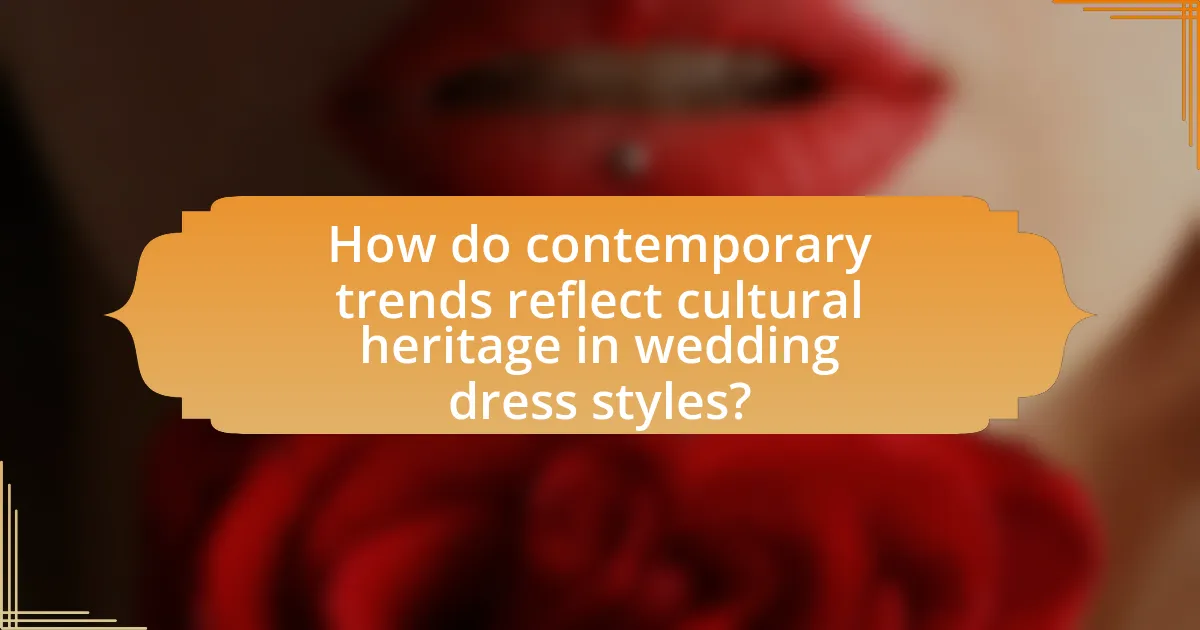
How do contemporary trends reflect cultural heritage in wedding dress styles?
Contemporary trends in wedding dress styles reflect cultural heritage through the incorporation of traditional fabrics, patterns, and silhouettes that honor historical practices. For example, many modern designers utilize lace, embroidery, and motifs that are significant to specific cultures, such as the intricate designs found in Indian bridal wear or the use of tartan in Scottish weddings. Additionally, the resurgence of vintage styles, like the A-line silhouette reminiscent of the 1950s, showcases a blend of nostalgia and cultural significance, as these styles often draw from the past to create a sense of identity and continuity. This blending of contemporary aesthetics with traditional elements not only celebrates cultural heritage but also allows for personal expression within the framework of modern wedding ceremonies.
What modern influences are reshaping traditional wedding dress designs?
Modern influences reshaping traditional wedding dress designs include sustainability, cultural diversity, and technological advancements. Sustainability has led designers to use eco-friendly materials and ethical production methods, reflecting a growing consumer demand for environmentally conscious fashion. Cultural diversity is evident as designers incorporate elements from various cultures, creating hybrid styles that celebrate global traditions. Technological advancements, such as 3D printing and digital design, allow for innovative silhouettes and customization options, enabling brides to personalize their dresses more than ever before. These influences collectively transform traditional wedding attire into contemporary expressions of identity and values.
How do designers incorporate cultural elements into contemporary wedding dresses?
Designers incorporate cultural elements into contemporary wedding dresses by integrating traditional fabrics, motifs, and silhouettes that reflect specific cultural heritages. For instance, many designers use intricate embroidery patterns that are significant to particular cultures, such as Indian zardozi work or African kente cloth, to enhance the visual storytelling of the dress. Additionally, silhouettes may be inspired by historical garments from various cultures, such as the A-line shape reminiscent of Western styles or the flowing designs found in Eastern traditions. This blending of cultural elements not only honors the heritage but also appeals to modern sensibilities, creating a unique fusion that resonates with diverse audiences.
What are the implications of globalization on wedding dress styles?
Globalization significantly influences wedding dress styles by promoting cross-cultural exchange and accessibility to diverse fashion trends. This phenomenon allows brides to incorporate elements from various cultures, leading to a fusion of traditional and contemporary designs. For instance, the rise of destination weddings has popularized styles such as the Indian lehenga or the Chinese qipao among Western brides, showcasing a blend of cultural heritage. Additionally, global fashion brands now offer wedding collections that reflect international influences, making unique styles more accessible. This trend is supported by the increasing presence of multicultural weddings, which further encourages the integration of diverse aesthetics into wedding attire.
How can couples honor their cultural heritage through their wedding attire?
Couples can honor their cultural heritage through their wedding attire by incorporating traditional garments, fabrics, and symbols that reflect their cultural backgrounds. For example, a bride may choose to wear a sari, kimono, or a dress adorned with cultural motifs, while the groom might opt for a kilt, sherwani, or other culturally significant attire. This practice not only showcases their heritage but also strengthens familial and community ties, as many cultures have specific customs and styles associated with weddings. Historical evidence shows that such attire often includes specific colors and patterns that hold cultural significance, enhancing the couple’s connection to their roots and traditions.
What are some tips for blending traditional and modern styles in wedding dresses?
To blend traditional and modern styles in wedding dresses, consider incorporating classic elements such as lace or embroidery with contemporary silhouettes like A-line or mermaid cuts. This approach allows for the preservation of cultural heritage while embracing current fashion trends. For instance, using traditional fabrics like silk or satin can enhance the dress’s elegance, while adding modern features like off-the-shoulder necklines or asymmetrical hemlines creates a fresh look. Additionally, accessorizing with modern jewelry or shoes can further bridge the gap between the two styles, ensuring a harmonious blend that respects tradition while celebrating modernity.
How can couples choose wedding dresses that reflect their cultural backgrounds?
Couples can choose wedding dresses that reflect their cultural backgrounds by researching traditional attire from their respective cultures and incorporating elements such as fabrics, colors, and designs that hold cultural significance. For instance, Indian brides often wear red or gold saris, symbolizing prosperity and fertility, while Chinese brides traditionally wear red dresses, representing good luck and happiness. By selecting styles that honor these cultural symbols, couples can create a wedding dress that is not only visually appealing but also rich in meaning and heritage.
What are the best practices for selecting a culturally inspired wedding dress?
The best practices for selecting a culturally inspired wedding dress include researching the cultural significance of the attire, ensuring authenticity in design, and considering personal comfort and style. Researching the cultural significance helps in understanding the traditions and meanings behind specific garments, which can enhance the emotional value of the dress. Ensuring authenticity in design involves selecting materials, colors, and patterns that are true to the culture being represented, as this respects the heritage and traditions associated with the attire. Additionally, considering personal comfort and style ensures that the bride feels confident and at ease on her special day, which is crucial for enjoying the wedding experience.
